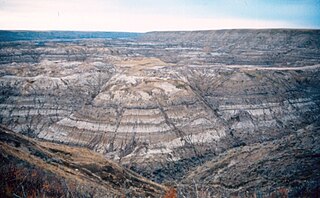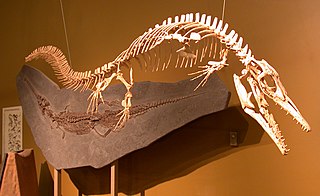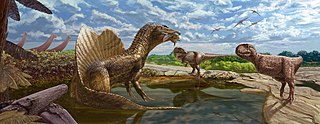
The Halisaurinae are a subfamily of mosasaurs, a group of Late Cretaceous marine lizards. They were small to medium-sized, ranging from just under 3 meters in Eonatator sternbergi to as much as 8 or 9 meters in Pluridens serpentis. They tended to have relatively slender jaws and small, numerous teeth, suggesting a diet of small fish and other prey. Although the skeleton is primitive compared to other Mosasauridae in many respects, halisaurines had the distinctive hypocercal tail of other mosasaurids suggesting good swimming ability, and they persisted alongside other mosasaurs until the end of the Cretaceous. The earliest known remains of halisaurines occur in rocks of Santonian age and the subfamily persists until the latest Maastrichtian. Halisaurines are known from North and South America, Europe, Asia and Africa, indicating a more or less global distribution in the Late Cretaceous. Four genera are currently recognized: Eonatator, Halisaurus, Phosphorosaurus and Pluridens.

The Horseshoe Canyon Formation is a stratigraphic unit of the Western Canada Sedimentary Basin in southwestern Alberta. It takes its name from Horseshoe Canyon, an area of badlands near Drumheller.

Halisaurus is an extinct genus of marine reptile belonging to the mosasaur family. The holotype, consisting of an angular and a basicranium fragment discovered near Hornerstown, New Jersey, already revealed a relatively unique combination of features and prompted a new genus to be described. It was named by Othniel Charles Marsh in 1869 and means "ocean lizard". It was renamed by Marsh to Baptosaurus in 1870, since he believed the name to already be preoccupied by the fish Halosaurus. According to modern rules, a difference of a letter is enough and the substitute name is unneeded, making "Baptosaurus" a junior synonym.

Saltasauridae is a family of armored herbivorous sauropods from the Upper Cretaceous. They are known from fossils found in South America, Africa, Asia, North America, and Europe. They are characterized by their vertebrae and feet, which are similar to those of Saltasaurus, the first of the group to be discovered and the source of the name. The last and largest of the group and only one found in North America, Alamosaurus, was thirty-four metres in length and one of the last sauropods to go extinct.

The Scollard Formation is an Upper Cretaceous to lower Palaeocene stratigraphic unit of the Western Canada Sedimentary Basin in southwestern Alberta. Its deposition spanned the time interval from latest Cretaceous to early Paleocene, and it includes sediments that were deposited before, during, and after the Cretaceous-Paleogene (K-Pg) extinction event. It is significant for its fossil record, and it includes the economically important coal deposits of the Ardley coal zone.

The Lameta Formation, also known as the Infratrappean Beds, is a sedimentary geological formation found in Madhya Pradesh, Gujarat, Maharashtra, Telangana, and Andhra Pradesh, India, associated with the Deccan Traps. It is of Maastrichtian age, and is notable for its dinosaur fossils. Many dubious names have been created for isolated bones, but several genera of dinosaurs from these rocks are well-supported, including the titanosaur sauropod Isisaurus and the abelisaurs Indosaurus, Indosuchus, Laevisuchus, and Rajasaurus. As well as mammals, snakes and other fossils.

The Bahariya Formation is a fossiliferous geologic formation dating back to the early Cenomanian, which outcrops within the Bahariya depression in Egypt, and is known from oil exploration drilling across much of the Western Desert where it forms an important oil reservoir.

Bothremydidae is an extinct family of side-necked turtles (Pleurodira) known from the Cretaceous and Cenozoic. They are closely related to Podocnemididae, and are amongst the most widely distributed pleurodire groups, with their fossils having been found in Africa, India, the Middle East, Europe, North America and South America. Bothremydids were aquatic turtles with a high morphological diversity, indicative of generalist, molluscivorous, piscivorous and possibly herbivorous grazing diets, with some probably capable of suction feeding. Unlike modern pleurodires, which are exclusively freshwater, bothremydids inhabited freshwater, marine and coastal environments. Their marine habits allowed bothremydids to disperse across oceanic barriers into Europe and North America during the early Late Cretaceous (Cenomanian). The youngest records of the group are indeterminate remains from Saudi Arabia and Oman, dating to the Miocene.

The Javelina Formation is a geological formation in Texas. Dating has shown that the strata date to the Maastrichtian stage of the Late Cretaceous, approximately 70 to 66.5 million years old. The middle part of the formation has been dated to about 69 million years ago plus or minus 1 million years and the top situated near the Cretaceous–Paleogene boundary, dated to 66 Ma ago. Dinosaur remains are among the fossils that have been recovered from the formation.
The Kakanaut Formation is a geological formation in Siberia, whose strata date back to the Late Cretaceous (Maastrichtian). Dinosaur remains are among the fossils that have been recovered from the formation. The flora of the formation is relictual, containing some of the youngest remains of the extinct plant orders Bennettitales and Czekanowskiales.
The Xiaoyan Formation is a geological formation in Anhui, China whose strata date back to the Late Cretaceous. Dinosaur remains are among the fossils that have been recovered from the formation. It overlies the older Qiyunshan Formation which it forms the Huangshan Basin with, and was deposited between the Campanian and Maastrichtian stages.

The La Colonia Formation is a geological formation in Argentina whose strata date back to the Late Cretaceous. Dinosaur remains are among the fossils that have been recovered from the formation.
The Harebell Formation is a Late Cretaceous (Maastrichtian) geologic formation in Wyoming which outcrops in parts of the Yellowstone National Park. Dinosaur remains diagnostic to the genus level are among the fossils that have been recovered from the formation.
The Marnes Rouges Inférieures Formation is a Late Cretaceous geologic formation found in the French Pyrenees. It predominantly consists of red mustone, with minor brown mudstone and sandstone. Dinosaurs, dinosaur eggs and avialian stem-birds have been reported from the formation.

Rahiolisaurus is a genus of abelisaurid theropod dinosaur which existed in India during the Late Cretaceous period. It was described in 2010, based on fossils recovered from the Lameta Formation in the Indian state of Gujarat. These fossils include elements from at least seven different individuals and are believed to have been from the Maastrichtian stage, sometime between 72.1 and 66 million years ago, making it one of the last non-avian dinosaurs known in the fossil record. Despite representing a variety of different growth stages, all recovered fossils from the locality indicate a single species, the type species Rahiolisaurus gujaratensis.

The Malargüe Group is a group of geologic formations of the Neuquén Basin of the Mendoza, Neuquén, Río Negro and La Pampa Provinces in northern Patagonia, Argentina. The formations of the Malargüe Group range in age between the middle Campanian to Deseadan, an Oligocene age of the SALMA classification, straddling the Cretaceous–Paleogene boundary, about 79 million to 30 million years in age. The group overlies the older Neuquén Group, separated by an unconformity dated to 79 Ma. The rocks of the Malargüe Group comprise both marine and continental deposits which are over 400 m (1312 ft) thick in total.

Phosphorosaurus is an extinct genus of marine lizard belonging to the mosasaur family. Phosphorosaurus is classified within the Halisaurinae subfamily alongside the genera Pluridens, Eonatator, and Halisaurus.

Hesham Sallam is an Egyptian paleontologist and the founder of the Mansoura University Vertebrate Paleontology Center (MUVP-C), the first vertebrate paleontology program in the Middle East. He works as an associate professor at the American University in Cairo and Mansoura University. Sallam led the discovery and description of Mansourasaurus shahinae, a species of sauropod dinosaur from Egypt, which has improved understanding of the prehistory of Africa during the latest Cretaceous period. His work has helped popularize paleontology in Egypt.
The Quseir Formation is a geological formation in the vicinity of the Kharga Oasis in Egypt. It is Campanian In age. The lithology largely consists of soft shale with hard bands of sandstone, siltstone and phosphorite. The environment of deposition was nearshore to freshwater fluvio-lacustrine characterized by moist and aquatic habitats with a tropical warm-humid climate. It is conformably overlain by the marine late Campanian-Maastrichtian Duwi Formation, and unconformably overlies the Turonian Taref Formation. The sauropod dinosaurs Mansourasaurus and Igai are known from the formation, as well as the proximal fibula of an indeterminate theropod. Additionally the lungfish genera Lavocatodus and Protopterus, the crocodyliform Wahasuchus and the bothremydid turtle Khargachelys are also known.

Abu Minqar is an oasis town in Qesm Al Wahat Ad Dakhlah District, New Valley Governorate, Egypt, about 93 kilometres (58 mi) by road southwest of Farafra. It is inhabited mainly by Bedouins and lies along a historical caravan route to Kufra, Libya.
















